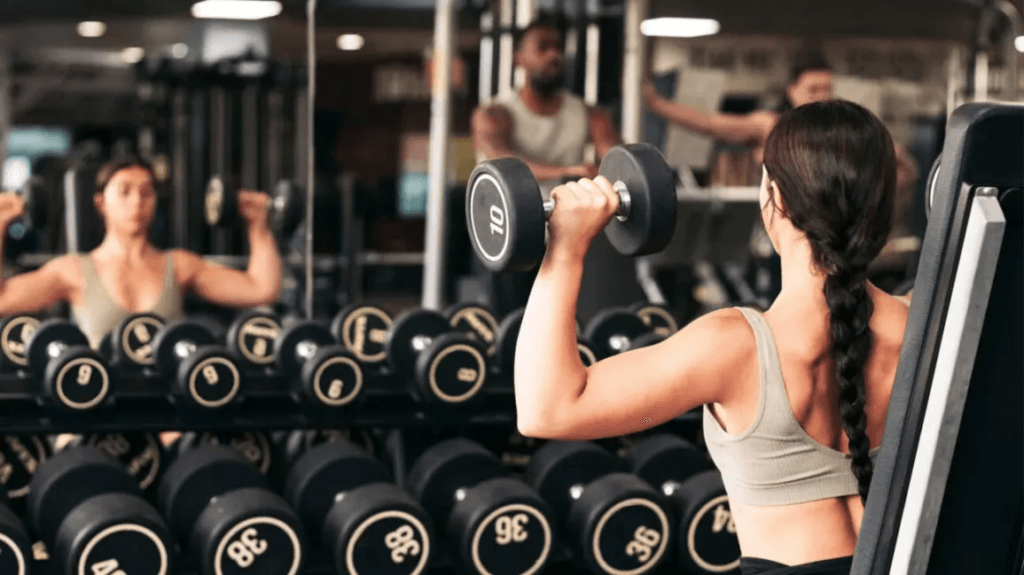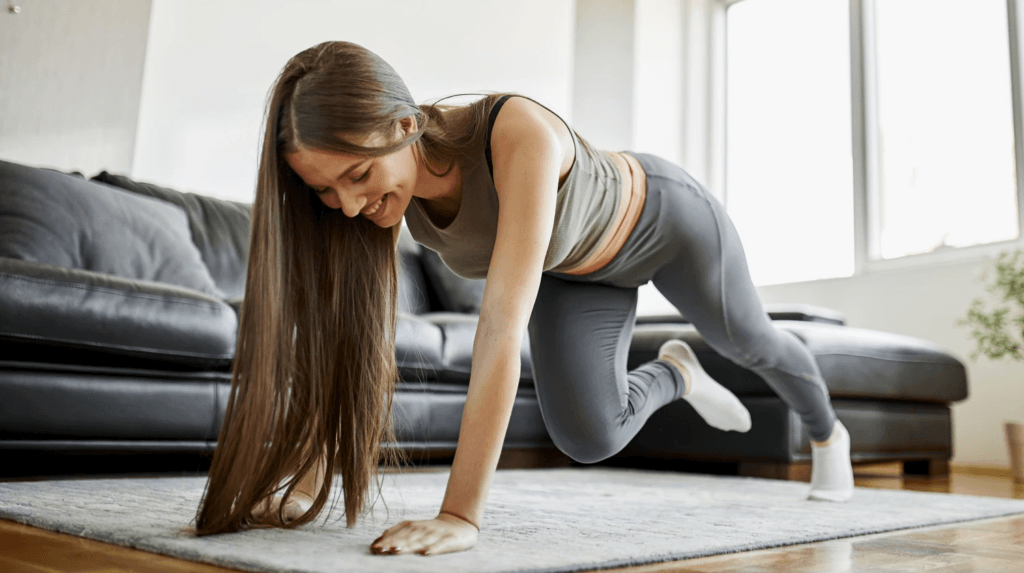Starting a workout routine at home can feel a bit overwhelming, especially if you’re new to fitness or haven’t exercised in a while. But the good news is that working out at home is convenient, cost-effective, and can be tailored to your fitness level and goals. Whether you’re aiming to lose weight, build muscle, or simply stay healthy, this guide will help you get started on the right foot. Let’s dive in!
Why Start a Home Workout Routine?

“Why should I start working out at home?” one may ask. Yes, there are a number of excellent reasons:
Convenience: You can work around the gym’s hours or avoid driving there. Whenever it’s convenient for you, you can work out—in the morning, at night, or even during your lunch break.
Cost-effective: Purchasing home exercise equipment is a one-time expense that can save you money over time compared to the high cost of gym memberships.
Privacy: Home workouts give you the opportunity to work out in the privacy of your own home, away from prying eyes, if you are uncomfortable working out in public.
Flexibility: Whether you’re working out for a quick 10-minute session or an hour-long program, you may customize your workouts to meet your demands.
Setting Realistic Goals
Prior to starting, you must establish reasonable objectives. Consider the goals you have for your at-home exercise regimen. Is it to maintain an active lifestyle, increase strength, increase flexibility, or decrease weight? Your objectives will dictate the kinds of exercises you perform and the frequency of your workouts.
Advice: Begin modestly. If you’re just starting out, it’s more realistic to aim for three times a week of exercise rather than daily workouts. The frequency can always be raised as soon as you feel more at ease.
Creating Your Workout Space
Starting a home exercise program doesn’t require a large room, but having a designated space helps keep you motivated and focused. What you’ll need is as follows:
A mat: A high-quality mat cushions your joints and improves the comfort of floor exercises.
Basic Equipment: A few pieces of equipment, such as dumbbells, resistance bands, or a jump rope, may be worthwhile investments based on your goals. If you don’t have these right away, don’t worry—you can still perform a lot of workouts using just your body weight.
Comfortable Clothes: Dress in items that fit well and don’t restrict your movement. Additionally, supportive shoes are essential, particularly if you want to perform high-impact workouts like stationary running or jumping.
A stopwatch or timer will allow you to record the length of your workouts and rest intervals.
Choosing the Right Exercises
Let’s now discuss the workouts you will be performing. Exercises that focus on the legs, arms, core, and back are essential components of a well-rounded at-home fitness program. Here’s a quick

1. Cardio Exercises
Cardiovascular exercise is crucial for calorie burning and heart health. At your house, you can:
Push-ups: Excellent exercise for the triceps, shoulders, and chest. Try push-ups on your knees if traditional push-ups are too difficult for you.
Squats: Great exercise for your glutes and legs. Maintain a straight back and place your knees behind your toes.
Plank: To strengthen your core, assume a plank posture. As you gain strength, progressively extend the duration from the initial 20 seconds.
3. Flexibility and Mobility

Remember to stretch! Flexibility exercises increase range of motion and help avoid injuries:
Hamstring Stretch: Sit on the floor with one leg extended, and reach for your toes.
Shoulder Stretch: Bring one arm across your chest and gently pull it closer with the other hand.
Cat-Cow Stretch: This yoga move is great for your back. Start on all fours, arch your back (cat), then dip your back towards the floor (cow).
Creating a Weekly Plan
If you want to see benefits from your at-home workouts, consistency is crucial. Here’s a basic weekly schedule to get you going:
Monday: Cardio (20-30 minutes)
Tuesday: Strength Training (Full Body)
Wednesday: Rest or Light Activity (like walking or stretching)
Thursday: Cardio (20-30 minutes)
Friday: Strength Training (Focus on Upper Body)
Saturday: Flexibility and Mobility Exercises
Sunday: Rest
This is simply a suggested plan; you can change the days and length to suit your schedule and level of fitness. Maintaining consistency and including exercise on a regular basis are crucial.
Staying Motivated

Maintaining motivation when working out at home is one of the toughest obstacles. The following advice will help you stay focused:
Establish Small Milestones: As an alternative to concentrating solely on long-term objectives, establish smaller ones, such as adding an extra push-up or ten seconds to your plank duration.
Track Your Progress: Utilize a fitness app or keep a notebook to record your efforts. Observing your development over time can be really inspiring.
Mix It Up: Vary your exercise regimen to prevent monotony. Try different workouts, change the routine’s order, or intensify it.
Reward Yourself: Upon reaching a goal, treat yourself to a small token of appreciation. It may be a nutritious treat, a soothing bath, or a new piece of exercise equipment.
Common Mistakes to Avoid
It’s critical to steer clear of typical blunders while beginning a home fitness program since they might cause injury or fatigue. Here are some things to be cautious of:
Doing Too Much, Too Soon: When you’re motivated, it’s easy to go all out, but doing too much too soon can hurt you. Increase your intensity progressively after starting out slowly.
Ignoring Warm-Ups: Before beginning any exercise, always warm up. This can be as easy as doing dynamic stretches or light exercise for five minutes.
Ignoring Rest Days: Especially if you’re performing strength training, your muscles need time to heal. Don’t forget to incorporate relaxation days into your schedule.
Ignoring Your Body: Observe how your body feels both during and after exercise. Stop and take a break if anything doesn’t feel right. It is advisable to avoid injuries by taking it easy.
The Importance of Nutrition
Exercise is but one aspect of living a healthy lifestyle. It’s crucial to provide your body the correct nutrients if you want to get the most out of your at-home exercise regimen. Pay attention to:
Protein: Aids in muscle growth and repair. Fish, tofu, beans, and chicken are all excellent sources.
Carbohydrates: Give your exercise energy. Choose fruits, veggies, and whole grains.
Good Fats: Vital to general well-being. Incorporate foods like almonds, avocados, and olive oil into your diet.
Hydration: To stay hydrated, sip lots of water prior to, during, and following your workouts.
In summary
Taking charge of your health and fitness may be enjoyable and rewarding when you start a home exercise regimen. Your fitness objectives can be achieved with a good plan, reasonable targets, and the correct mindset. Recall that persistence is essential; if you follow through, you’ll eventually achieve the desired outcomes. Above all, have fun with the process! It’s wonderful to hear about your path to improved fitness and health.
FAQs
How frequently ought I to exercise at home?
As you get more at ease, progressively increase from the initial three to four times each week.
Is equipment necessary for at-home exercise?
You can begin with bodyweight workouts, though. Consider making an investment in basic tools like dumbbells or resistance bands if you want to add more variation.
How long ought to my workouts at home be?
Set aside 20 to 30 minutes for each session, particularly in the beginning. As you increase your stamina, you can prolong the time.
What should I consume before my workout?
Eat a small carbohydrate and protein snack, such as a banana with peanut butter, 30 minutes to an hour before exercising.
Can I lose weight by exercising at home?
Yes, you can lose weight at home by exercising consistently and eating a well-balanced diet.













